T wave inversion - Study guides, Class notes & Summaries
Looking for the best study guides, study notes and summaries about T wave inversion? On this page you'll find 1008 study documents about T wave inversion.
Page 3 out of 1.008 results
Sort by
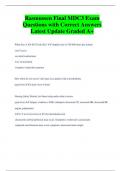
-
Rasmussen Final MDC3 Exam Questions with Correct Answers Latest Update Graded A+
- Exam (elaborations) • 34 pages • 2024
- Available in package deal
-
- $12.49
- + learn more
Rasmussen Final MDC3 Exam Questions with Correct Answers Latest Update Graded A+ What does A Fib ECG look like? -impulse rate of 350-600 times per minute -no P waves -no atrial contractions -loss of atrial kick -irregular ventricular response How often do you assess vital signs on a patient with a dysrhythmia (gray box) at least every 4 hours Nursing Safety Priority for Sinus tachycardia what to assess (gray box) -fatigue, weakness, SOB, orthopnea, decreased O2, increased HR, decre...
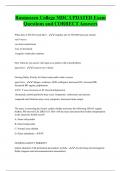
-
Rasmussen College MDC UPDATED Exam Questions and CORRECT Answers
- Exam (elaborations) • 25 pages • 2024
- Available in package deal
-
- $9.49
- + learn more
What does A Fib ECG look like? - -impulse rate of 350-600 times per minute -no P waves -no atrial contractions -loss of atrial kick -irregular ventricular response How often do you assess vital signs on a patient with a dysrhythmia (gray box) - at least every 4 hours Nursing Safety Priority for Sinus tachycardia what to assess (gray box) - -fatigue, weakness, SOB, orthopnea, decreased O2, increased HR, decreased BP, angina, palpitations -ECG: T wave inversion or ST elevation/depressi...
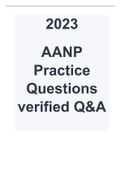
-
2023 AANP Practice Questions (verified Q&A).
- Exam (elaborations) • 34 pages • 2023
-
Available in package deal
-
- $14.49
- 2x sold
- + learn more
2023 AANP Practice Questions (verified Q&A) A 65-year-old woman presents for a follow-up examination after a new patient visit. She has not seen a healthcare provider for several years. She is a smoker and her hypertension is now adequately controlled with medication. Her mother died at age 40 from a heart attack. The fasting lipid profile shows cholesterol = 240 mg/dL, HDL = 30, and LDL = 200. In addition to starting Therapeutic Lifestyle Changes, the nurse practitioner should start the patien...
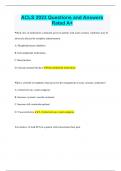
-
ACLS 2023 Questions and Answers Rated A+
- Exam (elaborations) • 35 pages • 2023
- Available in package deal
-
- $10.99
- + learn more
ACLS 2023 Questions and Answers Rated A+ Which class of medications commonly given to patients with acute coronary syndromes may be adversely affected by morphine administration A. Phosphodiesterase inhibitors B. Oral antiplatelet medications C. Beta blockers D. Calcium channel blockers Oral antiplatelet medications What is a benefit of morphine when given for the management of acute coronary syndromes? A. Central nervous system analgesia B. Increases systemic vascular resistance C. Incr...
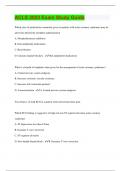
-
ACLS 2023 Exam Study Guide
- Exam (elaborations) • 29 pages • 2024
-
Available in package deal
-
- $9.99
- + learn more
ACLS 2023 Exam Study Guide Which class of medications commonly given to patients with acute coronary syndromes may be adversely affected by morphine administration A. Phosphodiesterase inhibitors B. Oral antiplatelet medications C. Beta blockers D. Calcium channel blockers - Oral antiplatelet medications What is a benefit of morphine when given for the management of acute coronary syndromes? A. Central nervous system analgesia B. Increases systemic vascular resistance C. Increases ...
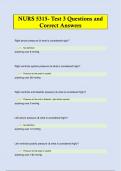
-
NURS 5315- Test 3 Questions and Correct Answers
- Exam (elaborations) • 24 pages • 2024
-
- $12.49
- + learn more
ST Elevation Myocardial Infarction (STEMI) ~ Myocardial infarction which results from a thrombus permanently lodging in the vessel which results in the progression of the myocardial infarction to include the entire thickness of the ventricular wall Cardiac Troponins ~ Very reliable way to diagnose MI -Can be detected in 2-4 hours after onset of pain and should be monitored -They peak at 24 hours and disappear within 7-10 days Myocardial ischemia ~ This is marked by T wave inversion ...
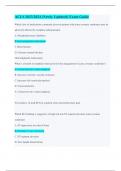
-
ACLS 2023/2024 (Newly Updated) Exam Guide
- Exam (elaborations) • 28 pages • 2024
- Available in package deal
-
- $13.99
- + learn more
ACLS 2023/2024 (Newly Updated) Exam Guide Which class of medications commonly given to patients with acute coronary syndromes may be adversely affected by morphine administration A. Phosphodiesterase inhibitors B. Oral antiplatelet medications C. Beta blockers D. Calcium channel blockers Oral antiplatelet medications What is a benefit of morphine when given for the management of acute coronary syndromes? A. Central nervous system analgesia B. Increases systemic vascular resistance C....
![PCCN Exam Review questions & Answers, VERIFIED/[LATEST EXAM UPDATES]](/docpics/5378043/664baee34d320_5378043_121_171.jpeg)
-
PCCN Exam Review questions & Answers, VERIFIED/[LATEST EXAM UPDATES]
- Exam (elaborations) • 71 pages • 2024
-
Available in package deal
-
- $11.49
- + learn more
PCCN Exam Review questions & Answers, VERIFIED/ Coronary artery perfusion is dependent upon: A. diastolic pressure B. systolic pressure C. afterload D. systemic vascular resistance (SVR) - -A. diastolic pressure Diastolic pressure in the aortic root is higher than left ventricular end-diastolic pressure (LVEDP), the pressure exerted on the ventricular muscle at the end of diastole when the ventricle is full. This enables blood to flow from a higher pressure through open arteries to a...

-
PCCN Exam Questions and Answers with Verified Solutions 2024 Graded A
- Exam (elaborations) • 56 pages • 2024
-
- $14.49
- + learn more
Coronary artery perfusion is dependent upon: A. diastolic pressure B. systolic pressure C. afterload D. systemic vascular resistance (SVR) - A. diastolic pressure Diastolic pressure in the aortic root is higher than left ventricular end-diastolic pressure (LVEDP), the pressure exerted on the ventricular muscle at the end of diastole when the ventricle is full. This enables blood to flow from a higher pressure through open arteries to a lower pressure, a pressure gradient known as coronary a...

-
NRSG 2500 Test 5 (Units 9 & 10) Multiple Questions Fully Solved.
- Exam (elaborations) • 12 pages • 2024
-
Available in package deal
-
- $9.99
- + learn more
LCA (left coronary artery) - Answer -supplies left ventricle anterior wall, intraventricular septum, bundle of his *LAD (left anterior descending); circ. or cx (circumflex) RCA (right coronary artery) - Answer -supplies right atria, anterior and posterior right ventricle, SA and AV nodes, bundle of his *marginal branch RCA; posterior descending branch of RCA Subendocardial or non-Q wave - Answer -involves layer below the endocardium Transmural or Q-wave - Answer -affected ...

Study stress? For sellers on Stuvia, these are actually golden times. KA-CHING! Earn from your study resources too and start uploading now. Discover all about earning on Stuvia


